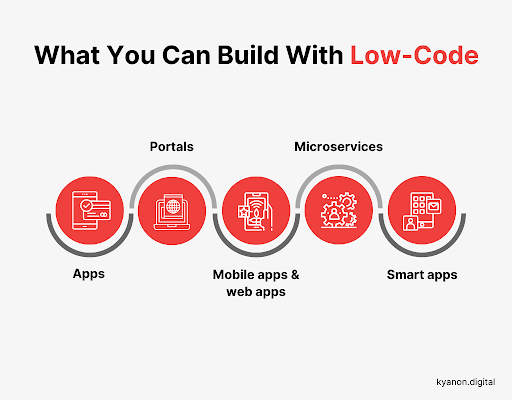Low-code development is an excellent method of creating applications that are able to seamlessly integrate diverse platforms and services. Here are the major advantages: Pre-built connectors and APIs:
Many Connectors Low-code software typically includes a library of prebuilt connectors for the most popular enterprise software (e.g. databases, CRMs ERPs, cloud-based services, and more). This makes it easier to integrate with systems.
API Integration: A lot of platforms offer out-of-the box API integration capabilities. Developers can easily connect with external data and services.
Easy to Use:
Drag-and--Drop integration Integration tasks are typically accomplished by using drag and-drop interfaces. Developers and non-developers can create sophisticated integrated systems without writing code.
Visual Workflow Designers: These software tools aid you in understanding and configuring integrations more easily.
Standardized Integration Methods:
SOAP/RESTful Service Support: Standard web service protocols, like SOAP/REST, facilitate the integration of various external applications and systems.
OData and other Standards: Supporting standards such as OData permits easy access to and manipulation of data across different platforms and applications.
Real-Time Data Synchronization:
Real-time Integrations: Low-code platforms can handle real-time data sync between applications and systems, assuring that the data is always current and uniform across the entire organization.
Event-Driven Architectures: Certain platforms offer event-driven architectures that enable applications to react in real-time whenever events occur, which is essential for applications that are dynamic.
Legacy System Integration:
Low-code platforms provide many tools for integrating with legacy systems. They allow organizations to modernize IT without overhauling their existing systems.
Data Migration Tools Built in data-migration tools make it easy to move data from old systems to low-code applications.
Third-Party service integration:
Cloud Services Integration: Easy scaling and deployment of apps can be achieved through seamless integration with cloud services such as AWS, Azure and Google Cloud.
Business Applications Integration: Lowcode platforms can be used to integrate different business applications like Salesforce, SAP, Microsoft Dynamics etc. to create a seamless workflow between different business functions.
Simplified Data management:
Unified Data Models: A few lowcode platforms have unification of coding models that simplify the management of data, integration and synchronization across various platforms.
Data Connectors Data connectors that are pre-configured make it easy to access and manipulate data from a variety of sources.
Security and Compliance
Low-code platforms help ensure integrations comply with security standards and protocols, protecting data in the process of transport and in its rest.
Features for Compliance - These platforms have features to make sure that the integrations are in compliance with the regulatory regulations.
Extensibility:
Custom Code and Scripts: To meet more intricate integration requirements Low-code platforms typically allow the inclusion of custom scripts and code, providing flexibility without compromising the user-friendliness of the.
Plug-in Ecosystem An ecosystem of extensions and plugins can extend integration capabilities through allowing users to easily add new functionality as required.
Overall, integration capabilities within low-code development platforms enable them to function as a strong platform for developing integrated and scalable, efficient and connected applications. These platforms streamline the process of integrating disparate IT systems, boost the flow of data, and aid companies adopt technologies that are already in use, while also leveraging new ones. Follow the top rated Low-code Platform for application development info for more tips including develop web application, azure sql, app development platform, app platforms, push notifications, develop cross platform mobile app, cloud software applications, software for app development, paas service, build a docker container and more.

Advantages Of Low Code Application Development For Governance And Security
Low-code development has several benefits regarding security and governance. These are important to ensure that apps are secure, compliant and properly managed throughout their lifecycle. Here are the most significant benefits: Centralized Governance
Unified management console: Low code platforms typically provide a centralized administration console, where administrators manage all applications and ensure that there is a consistent management within the company.
Role-Based Access Control (RBAC): These platforms typically include strong access control based on role that allows administrators to establish and enforce access policies. Only authorized users are permitted to modify and access specific areas of an application.
Compliance and Regulatory Adherence
Many low code platforms include built-in compliance features. These are built to ensure that applications comply with the industry standard (e.g. GDPR, HIPAA). They provide templates and tools to ensure that their applications comply with these regulations.
Audit Trails and Logging : Complete logging, audit trails and logs are typically integrated into companies that allow them to keep track of changes and track access. They can also make sure that the organization is in compliance with external and internal laws.
Increased Security Measures
Data Encryption Low-code systems typically include built-in encryption of data in transit and at rest, protecting sensitive data.
Security Certifications Many low-code sellers have security certificates (e.g. ISO 27001, SOC 2 ) that demonstrate compliance with high security standards. This gives additional security to the users.
Automated Security Updates
Regularly scheduled updates and patches: Low-code platforms typically manage regular patches and updates to security automatically, ensuring that applications are secure from most recent threats, without the need for manual intervention from developers.
Security Monitoring: Continuous monitoring of security tools are often provided, providing immediate alerts and insight into potential security issues.
Data Governance
Data Access Policies: These tools enable companies to establish the data access policies, enforce them and keep track of policies. This will ensure that the data is only accessible to authorized users and are used correctly.
Data Masking and Anonymization The built-in tools for masking data and anonymization can help safeguard sensitive data, particularly in development and testing environments.
Consistent Application Management:
Pipelines for Development and Delivery Low-code platforms typically include integrated development pipelines as well as delivery pipelines that include security tests. Security is assured throughout the entire lifecycle.
Version Control - Integrated version controls helps monitor changes to applications and allows the application to be reversed when needed. They also help maintain the integrity and quality of the software.
Authorization and User Authentication:
Single Sign-On: The support for SSO as well as other sophisticated authentication methods simplifies managing users and improves security.
Multi-Factor Authentication : Many platforms include integrated multi-factor authentication, which adds additional security when accessing apps.
Monitoring of Policy Enforcement and Compliance:
Low-code platforms are usually pre-defined with policy templates to assist organizations in implementing security and governance policies quickly.
Tools for Monitoring Compliance: These tools monitor and continuously report on the status of compliance. They help to spot issues and deal with the issues in a proactive way.
Integration with Existing Security Infrastructure
seamless integration: Low-code platforms are designed to work with current security software and infrastructure, including identity management systems, SIEM (Security Information and Event Management) solutions, and firewalls.
API Security: Built in API security features safeguard information, guarantee integrity of the application and secure integrations.
Training and best practices:
Good practices: Several platforms provide guidelines for the development of secure apps, as well as best practices. This assists non-developers to adhere to security standards.
Security Training Some low code companies offer security tools and training for users in order to help them understand how to build and maintain secure applications.
Overall, governance and application security advantages guarantee that applications are developed and maintained in a secure manner while remaining in compliance with the regulations, and under control. These platforms come with the frameworks, tools and regulatory compliance that are required to safeguard sensitive customer information, enforce policy, and ensure compliance with regulatory requirements as well as simplifying the management of and oversight over the application development process. Read the best Legacy application modernization with Low-code tips for blog examples including app development platform, cross platform app development, database in azure, low code platforms, cross platform mobile app development, develop web app, driver jdbc, push notifications, ms azure sql, build with docker and more.

Advantages Of Developing Applications Using Low-Code In Terms Of Limitations And The Possibility Of Customizing
Low-code development is an approach that is balanced to address issues, while allowing for customization. These are the main advantages: Resolving the limitations
Removing Complexity Barriers
Simple development: Low-code platforms streamline the process by providing templates and pre-built elements. This facilitates faster application deployment, even for complicated ones.
Many platforms have wizards and workflows with guided steps to help developers navigate complicated processes. These tools minimize the risk of mistakes and help ensure the consistency of.
Scalability Solutions
Scalability built-in Lowcode platforms typically include features that support scalable architecture. They allow applications to handle growing loads without major redevelopment.
Performance Monitoring: The integrated instruments for monitoring performance and optimization help ensure that applications remain efficient as they scale.
Security and Compliance
Integrated security features: Low-code platforms have security measures like encryption and access control based on role, and automated compliance checking, which address common security issues.
Regular Updates: Platforms regularly upgrade their security protocols and compliance measures, ensuring that their applications are secure against emerging threats.
Options for Customization:
Extensibility:
Low-code platforms permit developers to enhance functionality beyond the standard offerings by using custom code.
Developers can add customized modules or plugins to meet specific business needs.
APIs and Integration
API Support. A comprehensive API support enables seamless integration between external systems and service, allowing the most extensive customisation and connection.
Third-Party Platforms Lowcode platforms usually come already built with connectors to third-party apps, making it simpler to integrate them and customize the application.
Flexible UI/UX design:
Customizable User Interfaces: Developers can modify and design user interfaces to meet certain branding and usability requirements and provide a customized user experience.
Responsive Design The built-in capabilities of responsive design make sure that applications are able to be adapted to different devices and screen sizes.
Business Logic Customization:
Visual Workflow builders This tool lets developers build complex processes with minimal or no programming. They can create workflows and business logic visually.
Conditional Logic and Scripting: Platforms enable the use of conditional logic as well as customized scripting to deal with specific business rules and situations.
Data Management:
Custom Data Models: Developers have the ability to create custom data models to satisfy specific requirements of an application and make sure that data handling meets the requirements of business.
Advanced Data Processing: Integration with advanced tools and capabilities for data processing allow customizing how data is analysed, and used within your application.
How do you balance personalisation and limitations:
Frameworks and Standards:
Low-code platforms are compliant with the industry standard and best practice. This ensures secure and high-quality applications.
Governance Frameworks. The built-in governance frameworks make sure that any modifications do not compromise the security, integrity, or compliance of the application.
Feedback and iterative development:
Rapid Prototyping : Developers can quickly test their customizations and prototypes based on the feedback of users, improving the application in line with their preferences.
Continuous Improvement: Low-code platforms permit continuous improvement, allowing for constant customization and enhancements as business requirements evolve.
User Empowerment
Empowering Citizen Entwicklers: By giving non-developers the opportunity to personalize their apps using intuitive interfaces and low-code platforms they increase the number contributors who are able to enhance and tailor application.
Training and support: Many platforms provide extensive training resources and support services to assist users in making modifications that are effective without compromising an application's performance or stability.
Overall, Low-code application creation provides a framework that is robust and adaptable enough to handle restrictions while allowing plenty of customisation. This allows businesses to create and maintain applications that are efficient, adapted for their specific needs and that meet high standards of security, quality and scalability.
